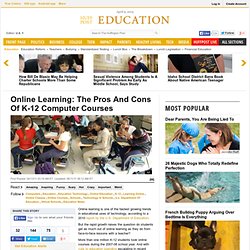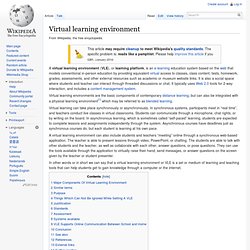

Pros and Cons of Virtual Education - Virtual Resources. Strengths and Weaknesses of Online Learning. Online Learning: The Pros And Cons Of K-12 Computer Courses. Online learning is one of the fastest growing trends in educational uses of technology, according to a 2010 report by the U.S.

Department of Education. But the rapid growth raises the question do students get as much out of online learning as they do from face-to-face lessons with a teacher? More than one million K-12 students took online courses during the 2007-08 school year. And with cuts to education spending escalating in recent years, online instruction is one option getting increasing attention as school districts look for ways to cut costs. A recent article in the New York Times highlights the debate over the efficacy of online classes for K-12 students. Proponents of online classes say they are a cost-effective alternative to traditional instruction that provide students more flexibility in their learning, as well as access to a greater variety of options. However, there isn't much research on the effectiveness of these virtual courses. That's not the only complaint. What is virtual learning environment (VLE) or managed learning environment (MLE.
A virtual learning environment (VLE) is a set of teaching and learning tools designed to enhance a student's learning experience by including computers and the Internet in the learning process.

The principal components of a VLE package include curriculum mapping (breaking curriculum into sections that can be assigned and assessed), student tracking, online support for both teacher and student, electronic communication (e-mail, threaded discussions, chat, Web publishing), and Internet links to outside curriculum resources. In general, VLE users are assigned either a teacher ID or a student ID. The teacher sees what a students sees, but the teacher has additional user rights to create or modify curriculum content and track student performance.
There are a number of commercial VLE software packages available, including Blackboard, WebCT, Lotus LearningSpace, and COSE. The Virtual Learning Resources Center indexes thousands of the best academic information websites, selected by teachers and library professionals worldwide, in order to provide to students and teachers current, valid information for school and university. Virtual learning environment. A virtual learning environment (VLE), or learning platform, is an e-learning education system based on the web that models conventional in-person education by providing equivalent virtual access to classes, class content, tests, homework, grades, assessments, and other external resources such as academic or museum website links.

It is also a social space where students and teacher can interact through threaded discussions or chat. It typically uses Web 2.0 tools for 2-way interaction, and includes a content management system. Virtual learning environments are the basic components of contemporary distance learning, but can also be integrated with a physical learning environment[1] which may be referred to as blended learning. Virtual learning can take place synchronously or asynchronously. In synchronous systems, participants meet in “real time”, and teachers conduct live classes in virtual classrooms. Major Components Of Virtual Learning Environment[edit] Similar terms[edit] Purpose[edit] Free Moodle. The Virtual Learning Organization.
Moodle teaching and learning. Moodle Tutorials: Overview and Index. Moodle.org: open-source community-based tools for learning. The School Library and the Virtual Learning Environment. Effective Learning and the Virtual Learning Environment. Effective Learning and the Virtual Learning Environment M J Stiles The Learning Development Centre, Staffordshire University, UK Abstract Using Virtual Learning Environments (VLEs) poses important educational issues for Universities. Without addressing the issues of effective learning, their use can compound the mistakes of the past and leave the learner with a passive, unengaging experience leading to surface learning. Educators need to recognise that learning is a social process and that providing an effective learning environment which facilitates the active acquisition of subject-specific and general expertise, and addresses the need to adopt a specific subject or professional culture, requires more than electronically delivered course notes and email discussion.
The Context There is an increasing worldwide drive to use the technologies based around the WWW as a means of addressing a number of challenges which face higher (and further) education. The Educational Problems. Dil.7.5.18. What is virtual learning environment (VLE) or managed learning environment (MLE)